By Jeremy Hance
NEWS on the Cerrado 
FACTS ON THE CERRADO
Land Areas: From approximately 2,031,990 square kilometers originally to 438,910 square kilometers today.Countries: Almost entirely in Brazil, though it extends a little into Paraguay and Bolivia.
Biodiversity: 10,400 species of plants, nearly half of which are endemic; 935 species of birds; 780 freshwater fish;113 amphibians; 180 reptiles; and almost 300 mammal species. In three insect orders surveyed: 14,425 species have been catalogued.
Extent of Habitat Cover: Just over 21 percent of the cerrado remains.
Habitat Loss Rate: 21,000 square kilometers of cerrado was destroyed annually between 2002 and 2008, twice the rate of the Amazon rainforest. Between 1984 and 2004, the cerrado ecosystem declined by 1.1 percent every year.
Causes of Habitat Loss: Mechanized soy farms, cattle ranches, and some other crops.
OVERVIEW: THE CERRADO
 Cerrado and transition forest in Mato Grosso |
Now the cerrado is one of Brazil's most threatened ecosystems. Half of the ecosystem has been destroyed for mechanized soy farms and cattle ranches. Over the past decade, two million hectares of the cerrado vanished every year to agriculture and pasture. Conservationists predict the possibility of a complete eradication of the ecosystem by 2030.
Long ignored by conservationists and environmentalists the cerrado is home to a shocking number of species, even given comparisons to its biologically-rich neighbors: the Amazon and the nearly-vanished Atlantic Forest. Of the ecosystems' some 10,000 species of plant, nearly half are endemic to the cerrado. Nearly a thousand birds and three-hundred mammals have been recorded in the cerrado as well. For a wooded savannah ecosystem with a long dry season, the cerrado is extremely rich in life.
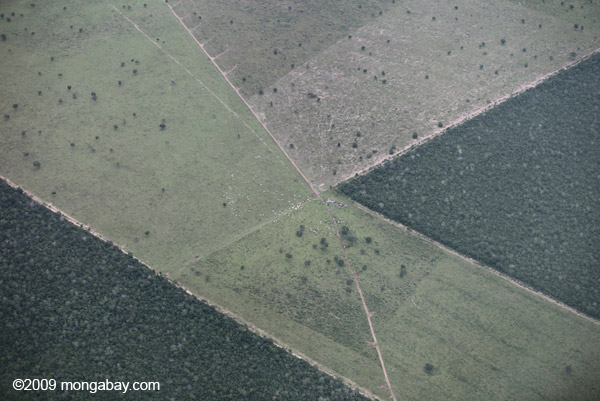 Deforested cerrado and transition forest in Mato Grosso |
Researchers have also begun to recognize the cerrado's importance for Brazil's waterways, since the headwaters of many of the nation's rivers begin in this savannah. The ecosystem plays an important role in carbon-cycling. Brazil's Environment Minister, Carlos Minc, has said that carbon emissions from the destruction of the cerrado are equal to those from the destruction of the Amazon.
POLITICAL GEOGRAPHY OF THE CERRADO 
The cerrado lies almost entirely in Brazil, though a small extent reaches into northeastern Paraguay and eastern Bolivia.
The ecosystem covers a number of central Brazilian states including Mato Grosso, Mato Grosso do Sul, Goiás Distrito Federal, and Tocantins; as well as western Minas Gerais and Bahia; southern Maranhão and Piauí; and small portions of São Paulo and Paraná.
ECOSYSTEMS OF THE CERRADO 
The cerrado is tropical savannah characterized by the annual average temperature of 68 degrees Fahrenheit (20 degrees Celsisu) to nearly 79 degrees Fahrenheit (26 degrees Celsius). The dry colder season extends from May to October. The soil is mostly nutrient poor.
The cerrado biome is home to a variety of ecosystems, including dry forests, grasslands, wetlands, shrublands, savannah, gallery forests, and even wet forests.
Gallery forests are trees and vegetation that line rivers and other waterways in otherwise savannah-type landscapes.
BIODIVERSITY PROFILE OF THE CERRADO 
 Greater Rhea (Rhea americana)  Jabiru stork  Hyacinth Macaw (Anodorhynchus hyacinthinus) |
In total, researchers have found nearly 300 species of mammals, 780 fish, 300 amphibians and reptiles, and 935 species of bird in the cerrado region. In addition, over 14,000 species of insect have been identified from just three insect orders out of 32: Lepidoptera (butterflies and moths), Hymenoptera (ants, bees, wasps, and sawflies), and Isoptera (termites).
But the biggest biological stunner of the cerrado is its plant species: 4,400 of the cerrado's 10,000 species of plants are found no-where else in the world. Due to a long dry season, these plants have evolved remarkable resistance both to fire and drought.
The uniqueness of the cerrado's plant life—and the rampant destruction of the ecosystem—makes these species especially vulnerable to extinction. A recent study estimated that plant species in the cerrado are twice as likely to go extinct than plants in other Brazilian ecosystems, including the Amazon.
New species are still being found in the cerrado: in 2007 two new species of lizard were described by researchers and in 2008 researchers announced the discovery of 14 species new to science: 8 fish, 3 reptiles, a bird, and even a new mammal.
While new species are being discovered, others have gone extinct. The candango mouse (Juscelinomys candango) was first described in 1965, but hasn't been seen since losing all of its habitat to urban development and suburban sprawl in Brasilia.
Some largely endemic species of the cerrado include:
- The dwarf tinamou (Taoniscus nanus) is a small bird endemic to the cerrado. It is listed as Vulnerable by the IUCN Red List due to habitat loss.
- The maned wolf's (Chrysocyon brachyurusrange) range is almost entirely found in the cerrado. Reddish in color this canid boasts long-legs likely for stalking and hunting in tall grasses. It is listed as Near Threatened by the IUCN Red List also due to habitat loss.
- The cerrado boasts 26 species of the reptiles known as snake-lizards in the genus Amphisbaenidae. Underground dwellers, most Amphisbaenas are without limbs. Six of these snake-lizards are known only in the cerrado.
- The white-winged nightjar (Eleothreptus candicans) is listed as Endangered by the IUCN Red List. As their name implies nightjars are most active after dark or during twilight and early morning.
- Americas' heaviest bird, the greater rhea (Rhea americana) haunts much of the cerrado. Males of this ostrich-like bird are the sole care takers of offspring. Like another megaufauna of the cerrado, the maned wolf, the greater rhea is considered Near Threatened.
CERRADO LOSS 
 Remaining cerrado cover in Brazil according to Dr. Ricardo Machado. |
A 2007 Conservation International study found that by 1985, 27 percent of the cerrado was lost. In less than twenty years (2004) the percentage lost rose to 57. During that time the cerrado declined 1.1 percent every year, while the Brazilian Amazon declined by less than 0.5 percent per year over the past decade.
CURRENT THREATS TO THE CERRADO 

|
In addition, the spread of soy and other crops (corn and rice) have indirectly impacted the Amazon rainforest: a boom in agriculture has pushed livestock from the cerrado into the Amazon's edges leading to continuing deforestation of the world's biggest rainforest.
 Clearing of cerrado and transition forest in Mato Grosso |
PROTECTED AREAS IN THE CERRADO 
To date approximately 7.5 percent of the cerrado is under protection.
Chapada dos Veadeiros National Park: Located in the state of Goias, Brazil, Chapada dos Veadeiros National Park spreads over 655 square kilometers on some of Brazil's highest plateaus. Sporting large canyons, dramatic mountains, and stunning waterfalls, this protected area in the cerrado has been listed as a UNESCO World Natural Heritage Site.
Emas National Park: Named after the greater rhea, Emas National Park is also a UNESCO World Natural Heritage Site. Home to rhea, jaguar, giant anteater, maned wolf, and pumas, the park, which is dominated in part by termite mounds, lies in central western Brazil and covers 1,300 square kilometers.
Serra do Tombador Nature Preserve: This is a private reserve created by the Nature Conservancy and the Brazilian organization, O Boticario. Covering 89 square miles kilometers, the reserve is small compared to some of the National Parks but represents a non-government designated protected area. The Nature Conservancy hopes to establish a corridor between the Serra do Tombador Nature Preserve and Chapada dos Veadeiros National Park.
PHOTOS OF THE CERRADO AND CERRADO WILDLIFE 
Photo story: How harvesting of cerrado fruits can help protect the ecosystem.
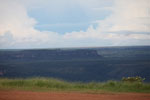 Mirante do Centro Geodésico 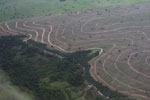 Recently cleared cerrado in Brazil |
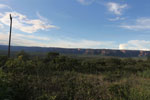 Mirante do Centro Geodésico 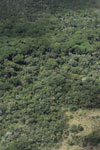 Cerrado-rainforest transition zone |
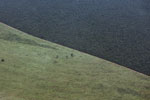 Cerrado and pasture 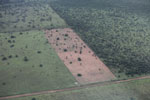 Ranchland and cerrado |
 Jaguar (Panthera onca). Photo by Rhett A. Butler 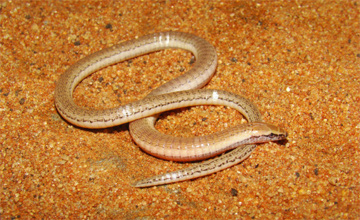 This species of lizard of the genus Bachia is one of the new species discovered during the expedition. Although there are other species of the genus in the Cerrado (almost all discovered and described only recently), this new species has only been recorded in the Ecological Station. The absence of legs and the sharply pointed snout help in locomotion over the surface layer of sandy soil, predominating in all the Jalapao, formed by the natural erosion of the escarpments of the Serra Geral plateaus. Photos by Miguel Trefaut Rodrigues 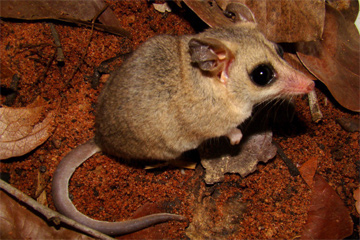 Some of the recorded species are relatively rare and little known, like this small fat-tailed mouse opossum of the genus Thylamys, registered for the first time in the Jalapao. Although this species was described from a Cerrado enclave within the Caatinga region, recent surveys have shown that the range of this species is concentrated in the northern portion of the Cerrado savannas. Photo by Agustin Camacho 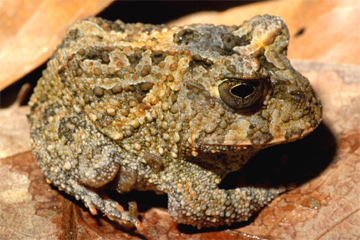 Other species such as this horned toad believed to be new to science of the genus Proceratophrys occupy very restricted areas. Protected areas like the EESGT are fundamental, because they shelter large populations of the species, reducing the threat of extinction from destruction of the habitats outside the reserves. Photo by Paula Hanna Valdujo. 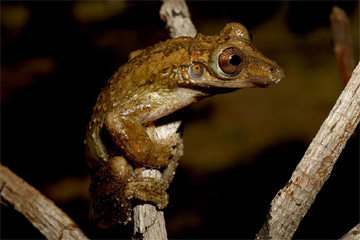 This species of amphibian (Corythomantis greeningi) occurs mainly in the Caatinga region, with only scant recordings in the Cerrado.The discovery of this species in the EESGT is the first recorded for the Jalapao region. The secretions of its skin can cause irritation to the eyes and nose. Photo by Paula Hanna Valdujo 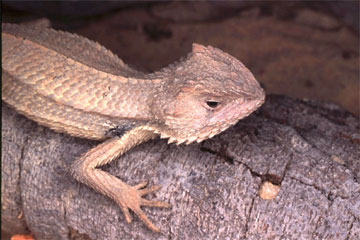 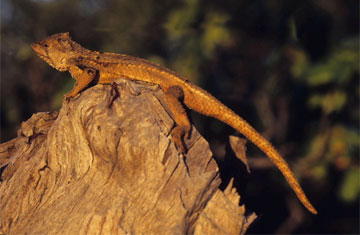 Top: Stenocercus quinarius lizard in Brazil (photo by Cristiano Nogueira). Bottom: Stenocercus squarrosus lizard in Serra das Confusões National Park, Brazil (photo by Andre Pessoa). |